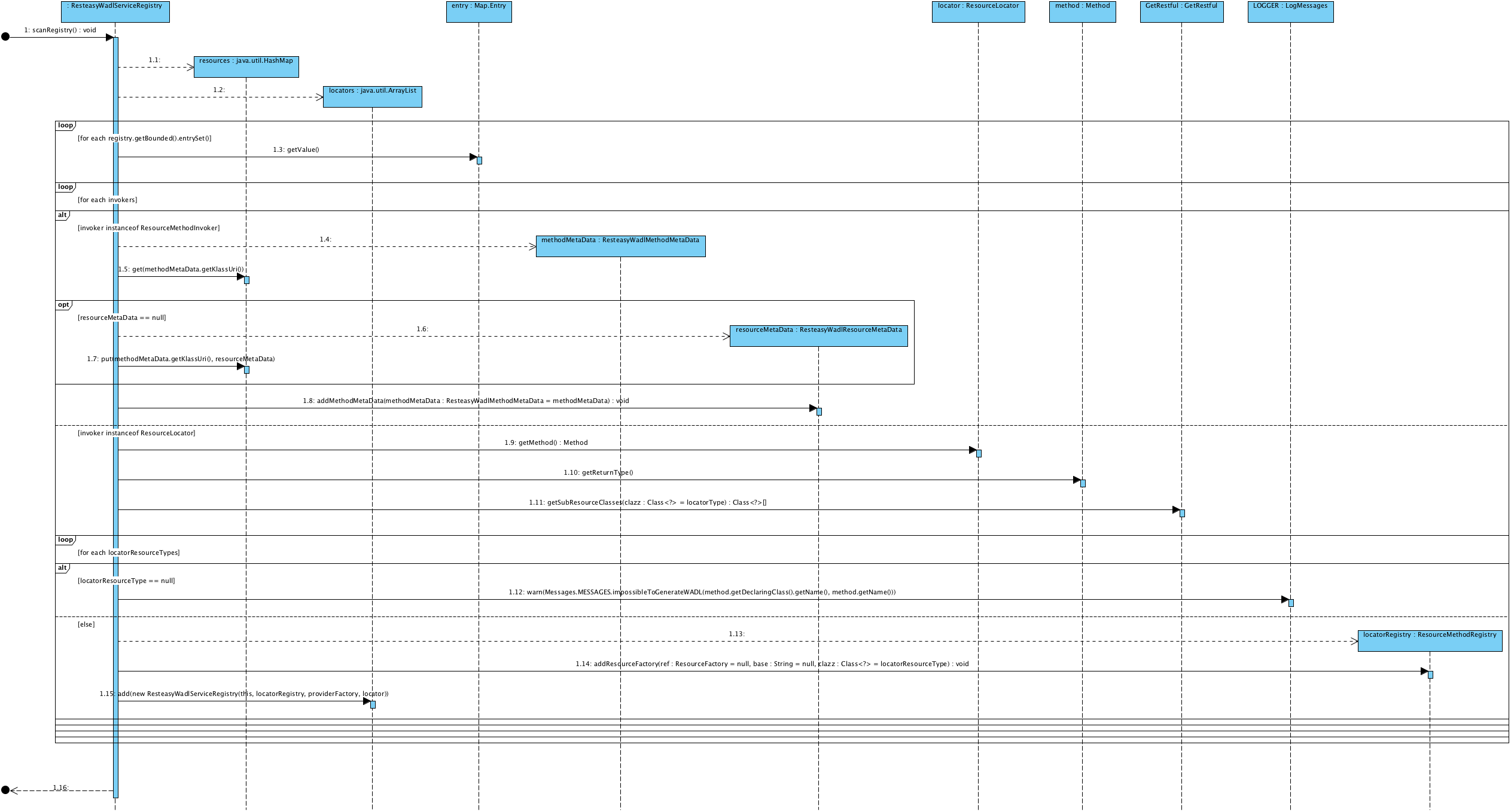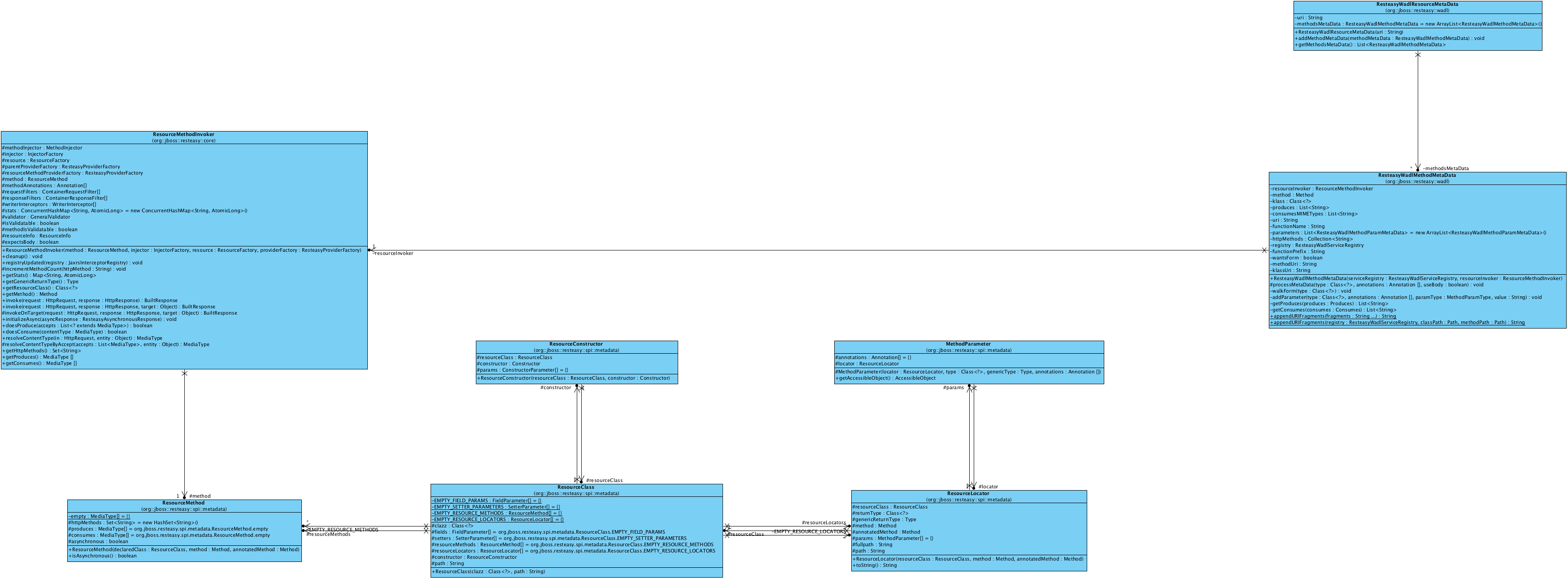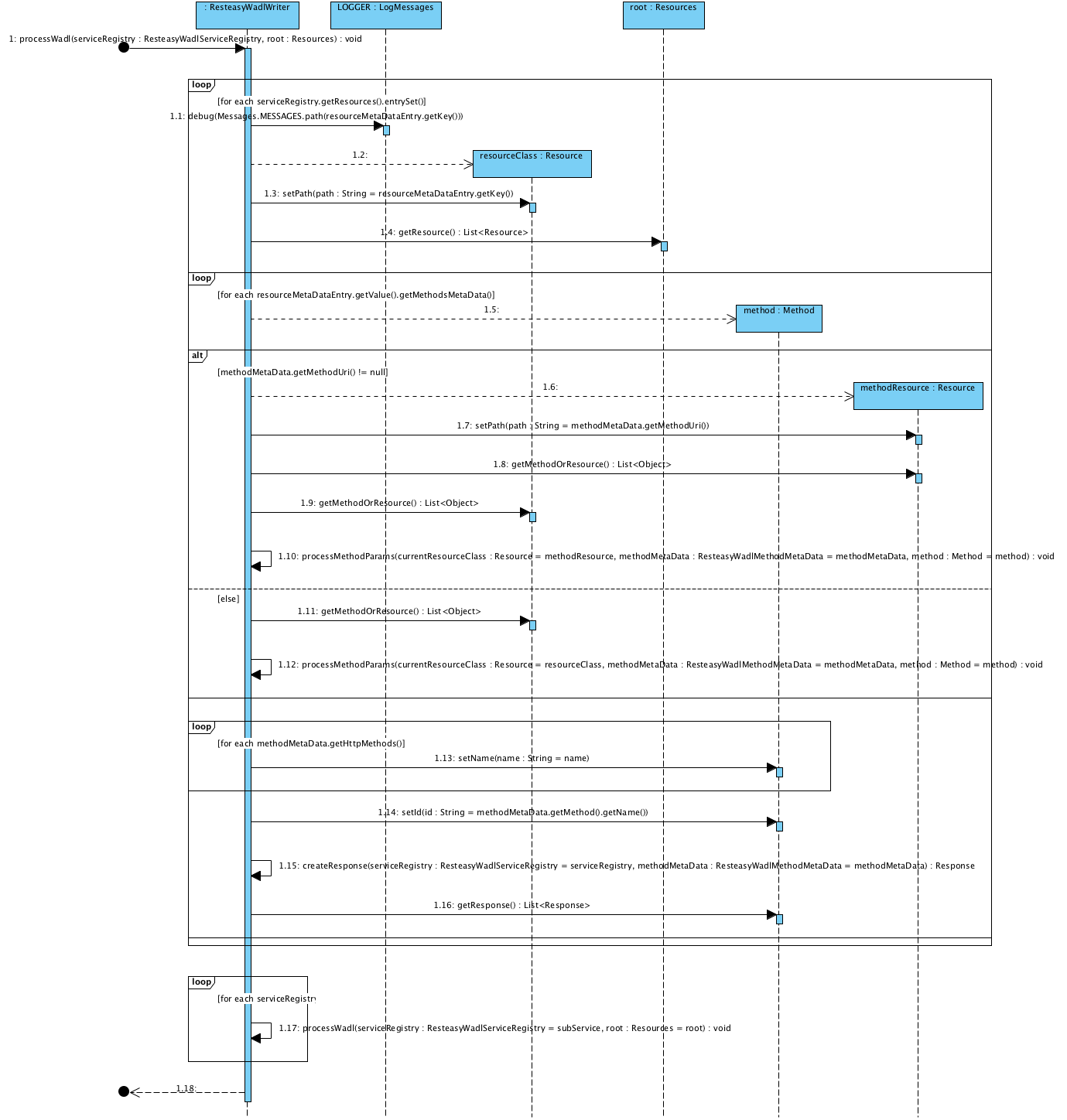Using RESTEasy WADL To Demonstrate The Startup Process Of RESTEasy Container
Using RESTEasy WADL To Demonstrate The Startup Process Of RESTEasy Container
RESTEasy WADL is a module that can generate WADL data for the restful resources. It needs to scan the RESTEasy container to get all the resources and methods information to generate the WADL data correctly, so analyzing the RESTEasy WADL intialization process can help us to better understanding the RESTEasy container structure. In this article I will use the code of RESTEasy WADL for this purpose.
In the WADL section of RESTEasy document1, it shows the usage of the WADL module. Here is the code shown in 51.2. RESTEasy WADL support for Sun JDK HTTP Server:
org.jboss.resteasy.plugins.server.sun.http.HttpContextBuilder contextBuilder =
new org.jboss.resteasy.plugins.server.sun.http.HttpContextBuilder();
contextBuilder.getDeployment().getActualResourceClasses()
.add(ResteasyWadlDefaultResource.class);
The above code show us how the resource classes are added into the ResteasyDeployment. The HttpContextBuilder is a RESTEasy wrapper class for the Sun JDK HTTP Server, and we don’t need to care about its details in this article. We need to understand the ResteasyWadlDefaultResource is added into ResteasyDeployment from above code. This tells us the ResteasyDeployment class stores all the resource classes. I won’t dive into the ResteasyDeployment in this article, but if you’d like to learn more about the core classes of RESTEasy you can check this2.
Now we can go on checking the following code in the document:
ResteasyWadlDefaultResource.getServices()
.put("/",
ResteasyWadlGenerator
.generateServiceRegistry(contextBuilder.getDeployment()));
From above code we can see the ResteasyWadlGenerator class is used to create the ResteasyWadlServiceRegistry. It will use the ResteasyDeployment to get all the resource classes and their method information. This is reasonable because ResteasyDeployment contains all the resources as we see above. Here is the code of ResteasyWadlGenerator:
public class ResteasyWadlGenerator {
public static ResteasyWadlServiceRegistry generateServiceRegistry(ResteasyDeployment deployment) {
ResourceMethodRegistry registry = (ResourceMethodRegistry) deployment.getRegistry();
ResteasyProviderFactory providerFactory = deployment.getProviderFactory();
ResteasyWadlServiceRegistry service = new ResteasyWadlServiceRegistry(null, registry, providerFactory, null);
return service;
}
}
From the above implementation, we can see the ResourceMethodRegistry and ResteasyProviderFactory are fetched from ResteasyDeployment. These two classes are put into ResteasyWadlServiceRegistry, so the ResourceMethodRegistry and ResteasyProviderFactory must contain sufficient information about restful resources, or ResteasyWadlServiceRegistry will not get all the necessary information about the resources. Now let’s see the class diagram of ResteasyWadlServiceRegistry and the relative classes it contains:

From the above diagram, we can see ResteasyWadlServiceRegistry contains ResourceMethodRegistry and ResteasyProviderFactory, and with these two classes, it can later fetch all the following classes it needs. Please note ResteasyWadlServiceRegistry stores two kinds of resources. The first kind is resources:
private Map<String, ResteasyWadlResourceMetaData> resources;
From the above Map data structure, we can guess the resources contain url <-> class entries, and ResteasyWadlResourceMetaData is used to store resource class information. The second kind is locators:
private List<ResteasyWadlServiceRegistry> locators;
This one contains resource locators, because resource locators are actually nested resources, so they are a list of ResteasyWadlServiceRegistry itself. We can check the scanRegistry() method of ResteasyWadlServiceRegistry to see how it fetches, processes and stores the resources information:

From the above sequence diagram we can see how ResteasyWadlServiceRegistry deals with two types of resources. If the resource type is ResourceMethodInvoker, then it will create ResteasyWadlMethodMetaData and ResteasyWadlResourceMetaData to store the resource classes and methods information. The name of this class is misleading, it should be called ResourceClassAndMethodInvoker, because it contains both resource class their methods information. Here is the relative code in scanRegistry() method:
if (invoker instanceof ResourceMethodInvoker) {
ResteasyWadlMethodMetaData methodMetaData = new ResteasyWadlMethodMetaData(this, (ResourceMethodInvoker) invoker);
ResteasyWadlResourceMetaData resourceMetaData = resources.get(methodMetaData.getKlassUri());
if (resourceMetaData == null) {
resourceMetaData = new ResteasyWadlResourceMetaData(methodMetaData.getKlassUri());
resources.put(methodMetaData.getKlassUri(), resourceMetaData);
}
resourceMetaData.addMethodMetaData(methodMetaData);
}
On other hand, if the resource type is ResourceLocator, then it will add the locator into the locators array. Here is the relative code:
else if (invoker instanceof ResourceLocator) {
ResourceMethodRegistry locatorRegistry = new ResourceMethodRegistry(providerFactory);
locatorRegistry.addResourceFactory(null, null, locatorResourceType);
locators.add(new ResteasyWadlServiceRegistry(this, locatorRegistry, providerFactory, locator));
}
The name of ResourceMethodRegistry is also misleading, it might be better called ResourceClassAndMethodRegistry because it also contains both resource classes and methods information. The instance of ResourceMethodRegistry is locatorRegistry, and it is passed to the constructor of ResteasyWadlServiceRegistry, and the created ResteasyWadlServiceRegistry is added into locators. This is the line of code that does this:
locators.add(new ResteasyWadlServiceRegistry(this, locatorRegistry, providerFactory, locator));
Please note the constructor of ResteasyWadlServiceRegistry will call the scanRegistry() method, so here we have a recursive call of scanRegistry() for resource locators. This implementation reflects the fact that resource locator is a kind of nested resource. Now let’s check the ResteasyWadlResourceMetaData and ResteasyWadlMethodMetaData:

From the above diagram, we can see ResteasyWadlResourceMetaData has a list of ResteasyWadlMethodMetaData, and ResteasyWadlMethodMetaData contains the ResourceMethodInvoker, and the ResourceMethodInvoker is the implementation class to do the actual resource method invocations. Now we can check how ResteasyWadlWriter uses ResteasyWadlResourceMetaData and ResteasyWadlMethodMetaData to convert resource classes and methods to WADL data:

From the above sequence diagram we can see how resourceMetaDataEntry and methodMetaData are used in processWadl method. Here is the relative code:
for (Map.Entry<String, ResteasyWadlResourceMetaData> resourceMetaDataEntry : serviceRegistry.getResources().entrySet()) {
resourceClass.setPath(resourceMetaDataEntry.getKey());
root.getResource().add(resourceClass);
for (ResteasyWadlMethodMetaData methodMetaData : resourceMetaDataEntry.getValue().getMethodsMetaData()) {
Method method = new Method();
}
}
In addition, at the end of the processWadl method, it deals with the resource locators in a recursive way:
for (ResteasyWadlServiceRegistry subService : serviceRegistry.getLocators())
processWadl(subService, root);
We can see again from here that the resource locators are just nested resources.